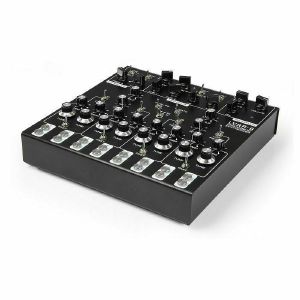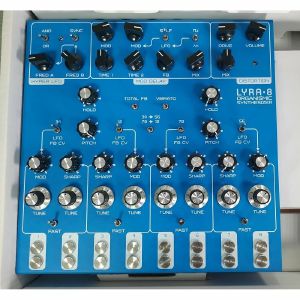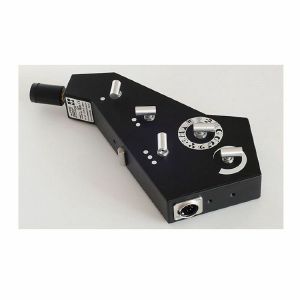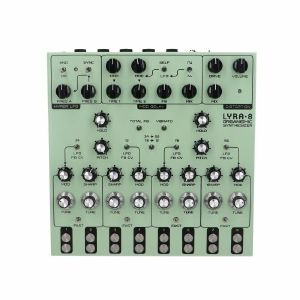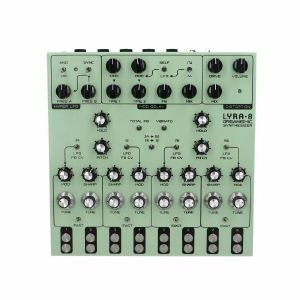Filter
Brand
Featured
Price
Tags
Synthesisers
Synthesisers – or synths – are the fundamental building blocks of most electronic music. Whether analogue or digital, a hardware synth is any instrument which generates sound using electronic circuits. Most of the great synths are keyboards, but there are a lot more choices, including desktop modules and modular systems.
Our range includes old-school analogue synthesisers and reissues of vintage classics, plus the latest digital workstations, patchable semi-modular instruments and portable models suitable for live performance or making music on the go.
With such a wide variety of synths on offer, there’s something to suit everyone, from budget options for beginners through to premium models for pro studios. Brands like Arturia, Korg and Roland offer excellent value for money, while the likes of Moog and Waldorf offer some of the best high-end options for those who want something a little more advanced.

Artículos del 1 al 6 de 6 en la página 1 de 1
Soma Laboratory Lyra-8 8-Voice Organismic Analogue Synthesiser (black) (analogue desktop synthesiser)
Cat: 781120 Rel: 08 Jul 20
8-voice organismic analogue synthesiser
Notes: Brilliantly unusual synth based on eight analogue tone generators, functioning more like an electric organ or FM synth than a conventional subtractive architecture. Unique sound.
Supplier notes:
Welcome to the world of sound of LYRA-8, the unique organismic analogue synthesizer designed by Vlad Kreimer. "Organismic" means that LYRA uses some principles that lie in the base of living organisms. The way how LYRA's modules interacting between each other and the behaviour of the instrument resembles a live conversation.
LYRA-8 is based on eight generators, which will be referred to as voices. Their design is not like a traditional subtractive synthesis VCO. Instead of having a linear or logarithmic dependency on control voltage, they resemble the tone generators in old electric organs. Hence the use of the term "voices" instead of VCOs. Lyra uses non-linearity a lot, and the voices are constructed in such a way that allows for non-linearity to express itself.
The voices are divided into four pairs (12, 34, 56, 78). All the pairs are divided in two groups, with two pairs in each (1234, 5678), creating tree-like structure.
The voices can function either in an electric organ mode or in an FM synthesis mode with each of the voices and its envelope acting as a separate FM operator. The voice's impact on FM synthesis will decrease along with the decay of its envelope.
LYRA-8 also has the next blocks:
The HYPER LFO is a complex low-frequency generator, whose waveform is synthesized from two simple LFOs by summation or multiplication of their frequencies. It also has a sync mode. The LFO can modulate the selected pairs of voices and the MOD DELAY.
The MOD DELAY consists of two lines of delay with cross-feedback and a special architecture that enables resonance between the two lines. Each line's delay time can be individually modulated from various sources, including external ones. The delay has a unique possibility of self-modulation where the output signal modulates the delay sample rate, creating cool effects.
The DISTORTION is last in the chain, after the delay. It enables the delay to also influence the distortion.
For all its experimental character, LYRA is a professional instrument. Its output dynamics and frequency response are balanced and ready for a live performance or studio recording without any additional processing.
… Read moreSupplier notes:
Welcome to the world of sound of LYRA-8, the unique organismic analogue synthesizer designed by Vlad Kreimer. "Organismic" means that LYRA uses some principles that lie in the base of living organisms. The way how LYRA's modules interacting between each other and the behaviour of the instrument resembles a live conversation.
LYRA-8 is based on eight generators, which will be referred to as voices. Their design is not like a traditional subtractive synthesis VCO. Instead of having a linear or logarithmic dependency on control voltage, they resemble the tone generators in old electric organs. Hence the use of the term "voices" instead of VCOs. Lyra uses non-linearity a lot, and the voices are constructed in such a way that allows for non-linearity to express itself.
The voices are divided into four pairs (12, 34, 56, 78). All the pairs are divided in two groups, with two pairs in each (1234, 5678), creating tree-like structure.
The voices can function either in an electric organ mode or in an FM synthesis mode with each of the voices and its envelope acting as a separate FM operator. The voice's impact on FM synthesis will decrease along with the decay of its envelope.
LYRA-8 also has the next blocks:
The HYPER LFO is a complex low-frequency generator, whose waveform is synthesized from two simple LFOs by summation or multiplication of their frequencies. It also has a sync mode. The LFO can modulate the selected pairs of voices and the MOD DELAY.
The MOD DELAY consists of two lines of delay with cross-feedback and a special architecture that enables resonance between the two lines. Each line's delay time can be individually modulated from various sources, including external ones. The delay has a unique possibility of self-modulation where the output signal modulates the delay sample rate, creating cool effects.
The DISTORTION is last in the chain, after the delay. It enables the delay to also influence the distortion.
For all its experimental character, LYRA is a professional instrument. Its output dynamics and frequency response are balanced and ready for a live performance or studio recording without any additional processing.
2 in stock $658.14
Soma Laboratory Lyra-8 8-Voice Organismic Analogue Synthesiser (zanzibar blue) (analogue desktop synthesiser)
Cat: 856134 Rel: 26 Nov 21
8-voice organismic analogue synthesiser
Notes: Brilliantly unusual synth based on eight analogue tone generators, functioning more like an electric organ or FM synth than a conventional subtractive architecture. Unique sound.
Supplier notes:
Welcome to the world of sound of LYRA-8, the unique organismic analogue synthesizer designed by Vlad Kreimer. "Organismic" means that LYRA uses some principles that lie in the base of living organisms. The way how LYRA's modules interacting between each other and the behaviour of the instrument resembles a live conversation.
LYRA-8 is based on eight generators, which will be referred to as voices. Their design is not like a traditional subtractive synthesis VCO. Instead of having a linear or logarithmic dependency on control voltage, they resemble the tone generators in old electric organs. Hence the use of the term "voices" instead of VCOs. Lyra uses non-linearity a lot, and the voices are constructed in such a way that allows for non-linearity to express itself.
The voices are divided into four pairs (12, 34, 56, 78). All the pairs are divided in two groups, with two pairs in each (1234, 5678), creating tree-like structure.
The voices can function either in an electric organ mode or in an FM synthesis mode with each of the voices and its envelope acting as a separate FM operator. The voice's impact on FM synthesis will decrease along with the decay of its envelope.
LYRA-8 also has the next blocks:
The HYPER LFO is a complex low-frequency generator, whose waveform is synthesized from two simple LFOs by summation or multiplication of their frequencies. It also has a sync mode. The LFO can modulate the selected pairs of voices and the MOD DELAY.
The MOD DELAY consists of two lines of delay with cross-feedback and a special architecture that enables resonance between the two lines. Each line's delay time can be individually modulated from various sources, including external ones. The delay has a unique possibility of self-modulation where the output signal modulates the delay sample rate, creating cool effects.
The DISTORTION is last in the chain, after the delay. It enables the delay to also influence the distortion.
For all its experimental character, LYRA is a professional instrument. Its output dynamics and frequency response are balanced and ready for a live performance or studio recording without any additional processing.
Specifications:
Max output voltage: 2 v 0-to-peak
Output connector: mono 6.3 mm TS or TRS (balanced) jack
Output resistance: 100 Ohm
EXT IN: 1 v 0-to-peak
EXT IN connector: 6.3 mm TS jack
HOLD GATE: full HOLD volume +5 V
HOLD GATE connector: 6.3 mm TS jack
CV DELAY : unipolar, range of 0 to +5 volt
CV DELAY connector: 6.3 mm TS jack
CV VOICES: unipolar, range of 0 to +5 volt
CV VOICES connector: 6.3 mm TS jack
Power supply: stabilised, +12 V, 0.2 A, centre positive
Power Consumption: 2 watt
Dimensions: 266 x 266 x 62 mm
Weight (without power supply and packaging): 2.5 kg
… Read moreSupplier notes:
Welcome to the world of sound of LYRA-8, the unique organismic analogue synthesizer designed by Vlad Kreimer. "Organismic" means that LYRA uses some principles that lie in the base of living organisms. The way how LYRA's modules interacting between each other and the behaviour of the instrument resembles a live conversation.
LYRA-8 is based on eight generators, which will be referred to as voices. Their design is not like a traditional subtractive synthesis VCO. Instead of having a linear or logarithmic dependency on control voltage, they resemble the tone generators in old electric organs. Hence the use of the term "voices" instead of VCOs. Lyra uses non-linearity a lot, and the voices are constructed in such a way that allows for non-linearity to express itself.
The voices are divided into four pairs (12, 34, 56, 78). All the pairs are divided in two groups, with two pairs in each (1234, 5678), creating tree-like structure.
The voices can function either in an electric organ mode or in an FM synthesis mode with each of the voices and its envelope acting as a separate FM operator. The voice's impact on FM synthesis will decrease along with the decay of its envelope.
LYRA-8 also has the next blocks:
The HYPER LFO is a complex low-frequency generator, whose waveform is synthesized from two simple LFOs by summation or multiplication of their frequencies. It also has a sync mode. The LFO can modulate the selected pairs of voices and the MOD DELAY.
The MOD DELAY consists of two lines of delay with cross-feedback and a special architecture that enables resonance between the two lines. Each line's delay time can be individually modulated from various sources, including external ones. The delay has a unique possibility of self-modulation where the output signal modulates the delay sample rate, creating cool effects.
The DISTORTION is last in the chain, after the delay. It enables the delay to also influence the distortion.
For all its experimental character, LYRA is a professional instrument. Its output dynamics and frequency response are balanced and ready for a live performance or studio recording without any additional processing.
Specifications:
Max output voltage: 2 v 0-to-peak
Output connector: mono 6.3 mm TS or TRS (balanced) jack
Output resistance: 100 Ohm
EXT IN: 1 v 0-to-peak
EXT IN connector: 6.3 mm TS jack
HOLD GATE: full HOLD volume +5 V
HOLD GATE connector: 6.3 mm TS jack
CV DELAY : unipolar, range of 0 to +5 volt
CV DELAY connector: 6.3 mm TS jack
CV VOICES: unipolar, range of 0 to +5 volt
CV VOICES connector: 6.3 mm TS jack
Power supply: stabilised, +12 V, 0.2 A, centre positive
Power Consumption: 2 watt
Dimensions: 266 x 266 x 62 mm
Weight (without power supply and packaging): 2.5 kg
1 in stock $717.54
Soma Laboratory The Pipe Voice Controlled Dynamic FX Processor & Synthesiser (black) (FX processor & synthesiser)
Cat: 781124 Rel: 08 Jul 20
Effects processor/synthesiser
Notes: THE PIPE is a voice / breath / mouth-controlled dynamic FX processor and synthesiser.
It turns your voice into a powerful FX / beat / lead / soundscape synthesizer and it offers unprecedented levels of vocal processing, truly expanding the traditional boundaries of singing. Conventional singing with lyrics is also possible, and you can use the FX to add live modulations to your vocal performance.
Also, you can use the PIPE as a powerful FX processor for an external signal as a synth, drum machine etc.
THE PIPE has 12 different algorithms: ORPHEUS, FILTERRA, SYNTH, REVERB, MADELAY, PULSE, BASSDRUM (three versions), OCTAVA, GENERATOR, HARCHO!
The PIPE consists of the handheld part and a small break-out box with L R output jacks (1/4-inch) and DC IN for power. The handheld part and break-out box are connected by a single cable that contains both output channels and DC power.
The handheld part consists of the contact vocal mic (connected by a standard 1/4-inch jack), electronic components and the controls. You can easily attach a cable extension to the mic which opens up many more options. Attach it to a stand, or put it inside of or on the surface of acoustic instruments such as drums, guitars, trumpets etc. Also, you can use the mic in jack as external in and use the PIPE to process any signals you want.
… Read moreIt turns your voice into a powerful FX / beat / lead / soundscape synthesizer and it offers unprecedented levels of vocal processing, truly expanding the traditional boundaries of singing. Conventional singing with lyrics is also possible, and you can use the FX to add live modulations to your vocal performance.
Also, you can use the PIPE as a powerful FX processor for an external signal as a synth, drum machine etc.
THE PIPE has 12 different algorithms: ORPHEUS, FILTERRA, SYNTH, REVERB, MADELAY, PULSE, BASSDRUM (three versions), OCTAVA, GENERATOR, HARCHO!
The PIPE consists of the handheld part and a small break-out box with L R output jacks (1/4-inch) and DC IN for power. The handheld part and break-out box are connected by a single cable that contains both output channels and DC power.
The handheld part consists of the contact vocal mic (connected by a standard 1/4-inch jack), electronic components and the controls. You can easily attach a cable extension to the mic which opens up many more options. Attach it to a stand, or put it inside of or on the surface of acoustic instruments such as drums, guitars, trumpets etc. Also, you can use the mic in jack as external in and use the PIPE to process any signals you want.
1 in stock $551.44
SoMa Laboratory Lyra-8 8-Voice Organismic Analogue Synthesiser (green) (analogue desktop synthesiser)
Cat: 1028772 Rel: 08 Jul 24
8-voice organismic analogue synthesiser
Notes: Welcome to the world of sound of LYRA-8, the unique organismic analogue synthesiser designed by Vlad Kreimer. "Organismic" means that LYRA uses some principles that lie in the base of living organisms. The way how LYRA's modules interacting between each other and the behaviour of the instrument resembles a live conversation.
LYRA-8 is based on eight generators, which will be referred to as voices. Their design is not like a traditional subtractive synthesis VCO. Instead of having a linear or logarithmic dependency on control voltage, they resemble the tone generators in old electric organs. Hence the use of the term "voices" instead of "VCOs". Lyra uses non-linearity a lot, and the voices are constructed in such a way that allows for non-linearity to express itself.
The voices are divided into four pairs (12, 34, 56, 78). All the pairs are divided in two groups, with two pairs in each (1234, 5678), creating tree-like structure.
The voices can function either in an electric organ mode or in an FM synthesis mode with each of the voices and its envelope acting as a separate FM operator. The voice's impact on FM synthesis will decrease along with the decay of its envelope.
LYRA-8 also has the next blocks:
The HYPER LFO is a complex low-frequency generator, whose waveform is synthesized from two simple LFOs by summation or multiplication of their frequencies. It also has a sync mode. The LFO can modulate the selected pairs of voices and the MOD DELAY.
The MOD DELAY consists of two lines of delay with cross-feedback and a special architecture that enables resonance between the two lines. Each line's delay time can be individually modulated from various sources, including external ones. The delay has a unique possibility of self-modulation where the output signal modulates the delay sample rate, creating cool effects.
The DISTORTION is last in the chain, after the delay. It enables the delay to also influence the distortion.
For all its experimental character, LYRA is a professional instrument. Its output dynamics and frequency response are balanced and ready for a live performance or studio recording without any additional processing.
Specifications:
Max output voltage: 2 v 0-to-peak
Output connector: mono 6.3 mm TS or TRS (balanced) jack
Output resistance: 100 Ohm
EXT IN: 1 v 0-to-peak
EXT IN connector: 6.3 mm TS jack
HOLD GATE: full HOLD volume +5 V
HOLD GATE connector: 6.3 mm TS jack
CV DELAY : unipolar, range of 0 to +5 volt
CV DELAY connector: 6.3 mm TS jack
CV VOICES: unipolar, range of 0 to +5 volt
CV VOICES connector: 6.3 mm TS jack
Power supply: stabilised, +12 V, 0.2 A, centre positive
Power Consumption: 2 watt
Dimensions: 266 x 266 x 62 mm
Weight (without power supply and packaging): 2.5 kg
… Read moreLYRA-8 is based on eight generators, which will be referred to as voices. Their design is not like a traditional subtractive synthesis VCO. Instead of having a linear or logarithmic dependency on control voltage, they resemble the tone generators in old electric organs. Hence the use of the term "voices" instead of "VCOs". Lyra uses non-linearity a lot, and the voices are constructed in such a way that allows for non-linearity to express itself.
The voices are divided into four pairs (12, 34, 56, 78). All the pairs are divided in two groups, with two pairs in each (1234, 5678), creating tree-like structure.
The voices can function either in an electric organ mode or in an FM synthesis mode with each of the voices and its envelope acting as a separate FM operator. The voice's impact on FM synthesis will decrease along with the decay of its envelope.
LYRA-8 also has the next blocks:
The HYPER LFO is a complex low-frequency generator, whose waveform is synthesized from two simple LFOs by summation or multiplication of their frequencies. It also has a sync mode. The LFO can modulate the selected pairs of voices and the MOD DELAY.
The MOD DELAY consists of two lines of delay with cross-feedback and a special architecture that enables resonance between the two lines. Each line's delay time can be individually modulated from various sources, including external ones. The delay has a unique possibility of self-modulation where the output signal modulates the delay sample rate, creating cool effects.
The DISTORTION is last in the chain, after the delay. It enables the delay to also influence the distortion.
For all its experimental character, LYRA is a professional instrument. Its output dynamics and frequency response are balanced and ready for a live performance or studio recording without any additional processing.
Specifications:
Max output voltage: 2 v 0-to-peak
Output connector: mono 6.3 mm TS or TRS (balanced) jack
Output resistance: 100 Ohm
EXT IN: 1 v 0-to-peak
EXT IN connector: 6.3 mm TS jack
HOLD GATE: full HOLD volume +5 V
HOLD GATE connector: 6.3 mm TS jack
CV DELAY : unipolar, range of 0 to +5 volt
CV DELAY connector: 6.3 mm TS jack
CV VOICES: unipolar, range of 0 to +5 volt
CV VOICES connector: 6.3 mm TS jack
Power supply: stabilised, +12 V, 0.2 A, centre positive
Power Consumption: 2 watt
Dimensions: 266 x 266 x 62 mm
Weight (without power supply and packaging): 2.5 kg
2 in stock $695.40
Soma Laboratory Lyra-8 8-Voice Organismic Analogue Synthesiser (orange) (analogue desktop synthesiser)
Cat: 1028791 Rel: 09 Jul 24
8-voice organismic analogue synthesiser
Notes: Welcome to the world of sound of LYRA-8, the unique organismic analogue synthesiser designed by Vlad Kreimer. "Organismic" means that LYRA uses some principles that lie in the base of living organisms. The way how LYRA's modules interacting between each other and the behaviour of the instrument resembles a live conversation.
LYRA-8 is based on eight generators, which will be referred to as voices. Their design is not like a traditional subtractive synthesis VCO. Instead of having a linear or logarithmic dependency on control voltage, they resemble the tone generators in old electric organs. Hence the use of the term "voices" instead of "VCOs". Lyra uses non-linearity a lot, and the voices are constructed in such a way that allows for non-linearity to express itself.
The voices are divided into four pairs (12, 34, 56, 78). All the pairs are divided in two groups, with two pairs in each (1234, 5678), creating tree-like structure.
The voices can function either in an electric organ mode or in an FM synthesis mode with each of the voices and its envelope acting as a separate FM operator. The voice's impact on FM synthesis will decrease along with the decay of its envelope.
LYRA-8 also has the next blocks:
The HYPER LFO is a complex low-frequency generator, whose waveform is synthesized from two simple LFOs by summation or multiplication of their frequencies. It also has a sync mode. The LFO can modulate the selected pairs of voices and the MOD DELAY.
The MOD DELAY consists of two lines of delay with cross-feedback and a special architecture that enables resonance between the two lines. Each line's delay time can be individually modulated from various sources, including external ones. The delay has a unique possibility of self-modulation where the output signal modulates the delay sample rate, creating cool effects.
The DISTORTION is last in the chain, after the delay. It enables the delay to also influence the distortion.
For all its experimental character, LYRA is a professional instrument. Its output dynamics and frequency response are balanced and ready for a live performance or studio recording without any additional processing.
… Read moreLYRA-8 is based on eight generators, which will be referred to as voices. Their design is not like a traditional subtractive synthesis VCO. Instead of having a linear or logarithmic dependency on control voltage, they resemble the tone generators in old electric organs. Hence the use of the term "voices" instead of "VCOs". Lyra uses non-linearity a lot, and the voices are constructed in such a way that allows for non-linearity to express itself.
The voices are divided into four pairs (12, 34, 56, 78). All the pairs are divided in two groups, with two pairs in each (1234, 5678), creating tree-like structure.
The voices can function either in an electric organ mode or in an FM synthesis mode with each of the voices and its envelope acting as a separate FM operator. The voice's impact on FM synthesis will decrease along with the decay of its envelope.
LYRA-8 also has the next blocks:
The HYPER LFO is a complex low-frequency generator, whose waveform is synthesized from two simple LFOs by summation or multiplication of their frequencies. It also has a sync mode. The LFO can modulate the selected pairs of voices and the MOD DELAY.
The MOD DELAY consists of two lines of delay with cross-feedback and a special architecture that enables resonance between the two lines. Each line's delay time can be individually modulated from various sources, including external ones. The delay has a unique possibility of self-modulation where the output signal modulates the delay sample rate, creating cool effects.
The DISTORTION is last in the chain, after the delay. It enables the delay to also influence the distortion.
For all its experimental character, LYRA is a professional instrument. Its output dynamics and frequency response are balanced and ready for a live performance or studio recording without any additional processing.
2 in stock $717.54
SoMa Laboratory Lyra-8 8-Voice Organismic Analogue Synthesiser (green) (B-STOCK) (analogue desktop synthesiser)
Cat: 1086770 Rel: 01 Jan 90
B-STOCK: Box opened, product in perfect working order
Notes: ***B-STOCK: Box opened, product in perfect working order***
Welcome to the world of sound of LYRA-8, the unique organismic analogue synthesiser designed by Vlad Kreimer. "Organismic" means that LYRA uses some principles that lie in the base of living organisms. The way how LYRA's modules interacting between each other and the behaviour of the instrument resembles a live conversation.
LYRA-8 is based on eight generators, which will be referred to as voices. Their design is not like a traditional subtractive synthesis VCO. Instead of having a linear or logarithmic dependency on control voltage, they resemble the tone generators in old electric organs. Hence the use of the term "voices" instead of "VCOs". Lyra uses non-linearity a lot, and the voices are constructed in such a way that allows for non-linearity to express itself.
The voices are divided into four pairs (12, 34, 56, 78). All the pairs are divided in two groups, with two pairs in each (1234, 5678), creating tree-like structure.
The voices can function either in an electric organ mode or in an FM synthesis mode with each of the voices and its envelope acting as a separate FM operator. The voice's impact on FM synthesis will decrease along with the decay of its envelope.
LYRA-8 also has the next blocks:
The HYPER LFO is a complex low-frequency generator, whose waveform is synthesized from two simple LFOs by summation or multiplication of their frequencies. It also has a sync mode. The LFO can modulate the selected pairs of voices and the MOD DELAY.
The MOD DELAY consists of two lines of delay with cross-feedback and a special architecture that enables resonance between the two lines. Each line's delay time can be individually modulated from various sources, including external ones. The delay has a unique possibility of self-modulation where the output signal modulates the delay sample rate, creating cool effects.
The DISTORTION is last in the chain, after the delay. It enables the delay to also influence the distortion.
For all its experimental character, LYRA is a professional instrument. Its output dynamics and frequency response are balanced and ready for a live performance or studio recording without any additional processing.
Specifications:
Max output voltage: 2 v 0-to-peak
Output connector: mono 6.3 mm TS or TRS (balanced) jack
Output resistance: 100 Ohm
EXT IN: 1 v 0-to-peak
EXT IN connector: 6.3 mm TS jack
HOLD GATE: full HOLD volume +5 V
HOLD GATE connector: 6.3 mm TS jack
CV DELAY : unipolar, range of 0 to +5 volt
CV DELAY connector: 6.3 mm TS jack
CV VOICES: unipolar, range of 0 to +5 volt
CV VOICES connector: 6.3 mm TS jack
Power supply: stabilised, +12 V, 0.2 A, centre positive
Power Consumption: 2 watt
Dimensions: 266 x 266 x 62 mm
Weight (without power supply and packaging): 2.5 kg
… Read moreWelcome to the world of sound of LYRA-8, the unique organismic analogue synthesiser designed by Vlad Kreimer. "Organismic" means that LYRA uses some principles that lie in the base of living organisms. The way how LYRA's modules interacting between each other and the behaviour of the instrument resembles a live conversation.
LYRA-8 is based on eight generators, which will be referred to as voices. Their design is not like a traditional subtractive synthesis VCO. Instead of having a linear or logarithmic dependency on control voltage, they resemble the tone generators in old electric organs. Hence the use of the term "voices" instead of "VCOs". Lyra uses non-linearity a lot, and the voices are constructed in such a way that allows for non-linearity to express itself.
The voices are divided into four pairs (12, 34, 56, 78). All the pairs are divided in two groups, with two pairs in each (1234, 5678), creating tree-like structure.
The voices can function either in an electric organ mode or in an FM synthesis mode with each of the voices and its envelope acting as a separate FM operator. The voice's impact on FM synthesis will decrease along with the decay of its envelope.
LYRA-8 also has the next blocks:
The HYPER LFO is a complex low-frequency generator, whose waveform is synthesized from two simple LFOs by summation or multiplication of their frequencies. It also has a sync mode. The LFO can modulate the selected pairs of voices and the MOD DELAY.
The MOD DELAY consists of two lines of delay with cross-feedback and a special architecture that enables resonance between the two lines. Each line's delay time can be individually modulated from various sources, including external ones. The delay has a unique possibility of self-modulation where the output signal modulates the delay sample rate, creating cool effects.
The DISTORTION is last in the chain, after the delay. It enables the delay to also influence the distortion.
For all its experimental character, LYRA is a professional instrument. Its output dynamics and frequency response are balanced and ready for a live performance or studio recording without any additional processing.
Specifications:
Max output voltage: 2 v 0-to-peak
Output connector: mono 6.3 mm TS or TRS (balanced) jack
Output resistance: 100 Ohm
EXT IN: 1 v 0-to-peak
EXT IN connector: 6.3 mm TS jack
HOLD GATE: full HOLD volume +5 V
HOLD GATE connector: 6.3 mm TS jack
CV DELAY : unipolar, range of 0 to +5 volt
CV DELAY connector: 6.3 mm TS jack
CV VOICES: unipolar, range of 0 to +5 volt
CV VOICES connector: 6.3 mm TS jack
Power supply: stabilised, +12 V, 0.2 A, centre positive
Power Consumption: 2 watt
Dimensions: 266 x 266 x 62 mm
Weight (without power supply and packaging): 2.5 kg
1 in stock $672.13
Artículos del 1 al 6 de 6 en la página 1 de 1

 USD
USD





